Flowers of German Bearded Iris
The showy flowers have two parts, the upright part of the growing German iris is called a standard and the draping part is a fall, containing the beard. Many are multi-colored, but solid-color German iris plants are the oldest types. Foliage is upright and sword-like. When growing German iris, you’ll find that most varieties are tall, good for a location at the back of the flower bed. Plants are available in both dwarf and intermediate heights for other areas of the garden. Stems that flowers grow on are sturdy and rarely need staking.
Tips for Growing German Iris
A few simple tips for German iris planting can get you started with growing this type of iris in the garden. These include:
Plant German iris “bulbs,” actually rhizomes, even with the soil. Planting too deeply encourages rot. Plant rhizomes in a loamy, well-draining soil. Growing German iris plants prefer a full sun location but will bloom in light shade.
Division of German Iris
Growing German iris is an easy way to add color to the spring and summer garden. Watering, fertilization with a high phosphorus fertilizer, and division every few years is necessary for the care of German irises. Division results in more prolific blooms and decreases the chance of soft rot and borer problems. Divide rhizomes of German iris every two to three years. If flowering has slowed on your German bearded iris, division may also be needed. When flowering has finished, lift German iris rhizomes from the soil with a garden fork. Replant the area, if desired, or leave some of the rhizomes in the ground. Plant extra rhizomes into other areas that will benefit from blooms of growing German iris.
